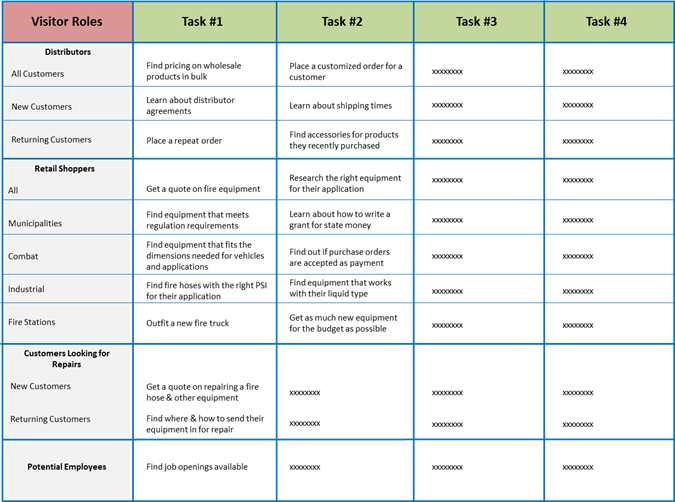Most business owners and executives want their businesses to grow. In order to do that, (let’s talk basic accounting) the total amount of deposits has to consistently exceed the total amount of withdrawals, or else the business is just treading water; or maybe even drowning. In this day and age, websites are one of the tools that can ultimately determine which direction your business goes. While it may not make or break all businesses at this point in time, it’s certainly critical for most.
What I’d like you to do for the next few minutes is to think about your website like you do your balance sheet. But, don’t just think about the numbers or how much the website costs to maintain versus how much revenue you can directly tie to it. Take it back a step. Take it all the way back to the user experience, because this is where it starts. Think about how a user’s experience with your website affects their relationship with your brand. Because when it comes to the numbers, the user experience is the cause. The numbers are just the effect.
See your site as a customer service tool
Every time a web user visits your website he or she has an interaction. These interactions are what make up the deposits and withdrawals. Every time something is quick, easy, obvious and transparent; there is a positive emotional deposit made into their emotional account. Every time something takes more effort than it should, is confusing, or is surprising; there is a withdrawal. Ultimately, their emotional “balance” affects your profit/loss sheet.
Since everyone is different, each user comes to your site with a different balance of tolerance. Naturally, you have no idea where that balance stands or how it’s been affected by the other events of their day. They could have just had a huge fight, the best news of their life or anywhere in between.
When tolerance is low, a web user may leave as soon as they arrive on your Homepage if they don’t see what they’re looking for. If their tolerance is high, they might put up with more before they leave. But, you don’t want to retain only the users with a high tolerance right? Of course not.
Since you can’t service each user individually based upon their emotional state, you’ve got to make sure you do your best to make it quick, easy, obvious and transparent to accomplish every task on your site that a user may come to use it for. After all, your website should be more like a customer service tool than a sales tool.
Am I saying your website shouldn’t sell? Not at all. But, it should sell by serving the customer, not herding them like sheep to the places you want them to go and information you want them to see. Remember, the customer experience with your brand isn’t experienced solely online or solely offline. It’s typically shared between both platforms. When you make it easy for users to complete their tasks on your site, the more likely they’ll continue down the purchasing funnel (or come back to go down it again as time goes on.)
With that said, there are some common general experiences that websites will put users through that tend to make withdrawals. I’m going to share 5 of them with you here. While there are always exceptions to general rules, if you apply these to your website, it’s likely you’ll find many ways in which your site is making withdrawals and be able to adjust to make deposits instead.
Experiences that make withdrawals
1. Vital Information is hard to find
Ever go and buy something online and get almost all the way through checkout before the shipping cost is presented to you? Ever have a support issue that requires calling a company, and hunting for their support number is like hunting for buried treasure? Websites shouldn’t hide information from users as a tactic to make or save money.
2. Playing the guessing game
Have you ever clicked on 3 or 4 links and subsequently had to hit the back button repeatedly before you find the right section of a site where the information you’re looking for is located? If users are guessing, your site isn’t communicating well enough..
3. Asking for unnecessary information
Ever get asked for your phone number in a form when you’re just trying to download something? Ever get asked what your occupation is when creating an account on a site? Users feel…used when you just want data from them for your own purposes.
4. Over-Marketing
Ever visit a site and get forced to close a pop-up ad before even entering the site? Ever arrive on a homepage and get distracted by a slide presentation that tries to sell you stuff? Users come to your site to complete tasks. Anything that gets in the way of that typically makes a withdrawal.
5. Telling me I made an error because you didn’t tell me how NOT to make the error.
Ever enter credit card information or your birth date and be told you made a formatting error, only to discover the site doesn’t give you an example of the correct format?
While you may be able to identify some of these user experience withdrawals by spending time going through your own site, it’s not recommended that this is the only activity you do. This is because of a psychological principle called the Curse of Knowledge. The basic premise of the principle is that you as the site owner/developer/marketer know too much. You know what things mean, you know where things are, you know what you’re supposed to do, etc. This causes you to have blind spots for things that are true regarding a user’s experience who doesn’t have those luxuries.
Instead, it is much more valuable to do usability testing, which can be very cheap and quite easy given where technology is at nowadays.
Turning withdrawals into deposits
It’s not enough just to get rid of the withdrawals, or else your balance never goes up. You don’t want to just eliminate withdrawals. You want to make deposits so that your site doesn’t just sustain your business, but helps it GROW. This stuff will help your site do just that…
1. Do a “task completion outline” for your site and make necessary changes.
This entails mapping out all of the major types of visitor roles that come to your site, segmenting them by their needs, listing the common tasks that each visitor might be looking to accomplish; then identifying content, architecture and functionality that will support each task.
Site owners like to map out what their website is going to look like and the content that it will contain, but they typically don’t first map out how it needs to service the users it exists for. Doing this would supply a nice guide to the design and architecture of your site.
Take a look at the example matrix I’ve started below for a company that sells fire equipment. While certainly not exhaustive (it’s not complete yet) it gives you an idea of the different types of users this site would serve and the types of tasks they might be looking to accomplish. As you start to build out your own, you’ll get a sense of how many tasks your consumers use your site for, and those that you’re not addressing optimally.
2. Disclose the things you’d like to hide.
Online, the user is in control. We’ve moved into the age where brands have to be “naked” to be successful. Users (mostly) know all the tricks, and if you try to pull them, you’ll have a net loss of brand equity in the end. So don’t hide your support number or shipping costs or your return policy or anything you’d rather not share with users that they are going to want to know.
3. Make easy things even easier.
Is it easy to enter numbers into a form field multiple times? Sure. But, it would be easier if I was told how I should format them. Is it easy to go to the UPS site and look up my tracking number? Sure. But, it would be easier if I could just click a link in an email to get me directly where I want to go.
4. Give users what they want, not what you wish they wanted.
Sites are notorious for pushing things they want people to do, instead of focusing on what users want to do. This is why you see the big slide shows on Homepages that highlight what’s new with the company or what charity event they just sponsored or what whitepaper they just put out or whatever. These things are fine to talk about and offer in appropriate places of the site where users have expressed their desire for such things by choosing to navigate to them. But, it’s not good when these types of things are inserted into the customer experience in places where they distract and take up precious real estate that should be used for helping users complete their tasks.
5. Be timely.
If a person has a question about something currently going on with your company, your site should have the answer and it should be easy to find. This is especially the case if it affects the customer experience (e.g. affects when their item will ship or their travel plans or the hours you’ll be open on an upcoming holiday).
I’ve never seen a site that made all deposits and no withdrawals. Who knows, it might not even be possible because users can be so different. But if you observe users and analyze the right data from your site, you will discover deposits and withdrawals constantly. Doing this type of audit consistently will help to ensure that your website is a tool that helps your business grow and not just get by.



4 Responses to 5 Website User Experience Mistakes That Hurt Your Bank Account